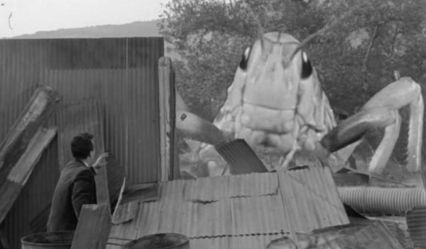The Beginning of the End
Today’s post seems particularly important since the world ended yesterday. So, without further ado, I bring you the giant grasshopper apocalypse.
If you’ve never watched Bert I. Gordon’s delightfully horrible The Beginning of the End, you’re missing out on an American film that aspires to B-movie status. Starring Peter Graves and Peggie Castle, this absurd piece of cinema history features a plucky photojournalist (Castle), a heroic agriculturalist (Graves), and an assortment of bit players doing a poor job of pretending horror in the face of ravenous grasshoppers grown to monstrous proportions after eating radiation-treated giant fruits, vegetables, and grains.
Get it? A radiation-based science project designed to end world hunger creates a swarm of giant locusts that threaten to devour the world’s food supply? Ooh. Irony.
If you’re brave enough, here’s the trailer. After the pic below, you’ll find giant grasshoppers for two game systems.

Presenting the Megalocust, first for Mutant Future and then for Advanced Dungeons & Dragons.
Alignment: Neutral
Movement: 120′ (40′)
Armor Class: 4
Hit Dice: 12
Attacks: 1 (bite or trample)
Damage: 3d6 or 6d6
Save: L5
Morale: 8
Hoard Class: None
XP: 3,800
Mutations: Poison Resistance, Reflective Epidermis (radiation), Sonic Suspectibility
The megalocust is a flightless grasshopper the size of a school bus. It has a voracious appetite, and it does not distinguish between animal or vegetable matter. In close combat, it attacks with a powerful bite (1-2) or tramples its target (4-6). The megalocust has a +4 to its attack roll when attempting to trample a foe that is smaller or approximately equal to the size of a horse. This mutant is immune to the effects of radiation. It suffers only half damage from poison, or no damage at all with a successful saving throw. The megalocust is vulnerable to sonic attacks and effects. It takes +1 point of damage per die from sonic attacks that cause damage. Against other effects, it suffers a -4 penalty to its saving throws.
What makes the megalocust most dangerous is that it maybe encountered as part of a swarm (25%) rather than a solitary creature (75%). A swarm contains 5d10+50 megalocusts.
Frequency: Rare
No. Appearing: 1-4 (75%) or 55-100 (25%)
Armor Class: 4
Move: 12″
Hit Dice: 12
% in Lair: Nil
Treasure Type: Nil
No. of Attacks: 1
Damage/Attack: 3-18
Special Attacks: Trample
Special Defenses: See below
Magic Resistance: Standard
Intelligence: Animal
Alignment: Neutral
Size: L (about 40 feet long)
Psionic Ability: Nil
Attack/Defense Modes: Nil
Level/X.P. Value: VII/2,700+16/hp
The megalocust is an enormous, ravenous insect most often encountered alone or in small numbers. Some of the time, however, megalocusts breed in prodigious numbers and form a swarm. In combat, the megalocust attacks with a powerful bite, but most of the time smaller creatures simply will be trampled for 6-36 points of damage. The megalocust is immune to electricity and poison. It suffers double damage from sound-based attacks (where applicable), and has a -4 penalty to its saving throws against such effects.

Leave a Reply